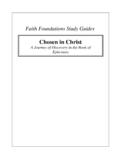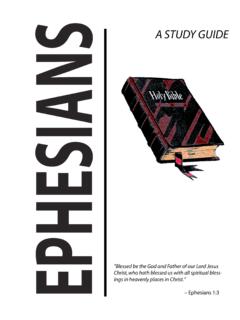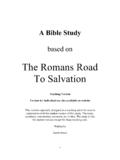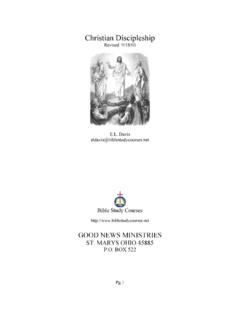Transcription of The Grace of God - journeychurchonline.org
1 The Grace of GodA Journey of Discovery in the Book of RomansFaith Foundations study Guides Alan Perkins 1993, 1995 All rights reserved. Printed in otherwise noted, Scripture quotations in this publication are from theHOLY BIBLE, NEW INTERNATIONAL VERSION .NIV Copyright 1973, 1978, 1984 by International Bible by permission. All rights to Use This BookWelcome to the Faith Foundations study guide on John! Whether you are just beginning your newlife with Christ, or have been a Christian for manyyears, this study guide is for you. It is designed tohelp you discover, through personal study andgroup discussion, the incredible riches of God sWord, and to help you grow in your walk with Godby applying what you learn. This book is dividedinto 26 lessons, each of which contains the fullNIV text of the Scripture passage, several studyand discussion questions, and a verse-by-versecommentary.
2 So, together with a Bible to look upcross-references, you have everything you need foryour "journey of discovery" in John s Small Groups? These materials can be used profitably inpersonal study or in an adult Sunday School their value will be best realized when they areused in small groups, meeting either at churchduring the Sunday School hour or in homes duringthe week. There are several reasons for this. First, no one has perfect insight into every passage of Scripture; we can all benefit fromhearing the perspectives of other believers as weseek to understand and apply the Bible. A smallgroup gathering, using the discussion questionsincluded in this book, is an ideal way to stimulate asharing of observations and ideas.
3 Second, a small group provides a community offellow travelers who, along with us, are seeking tofollow Christ in the midst of family responsibilities,job pressures, and personal struggles. In today sfragmented and mobile society, the naturalnetworks of neighborhoods and family no longerprovide the support they once did. We need someway of making connections with others for mutualsupport, people with whom we can share our joysand sorrows ---- people who will listen, who willpray with us, who will offer a helping hand and aword of encouragement, and who will confront usin love when we ve gotten off track. Finally, a small group combines the benefits ofBiblical insight and community support by keepingus accountable. If we only study the Scripturesalone, or listen to them taught in a large group, it seasy to let them go "in one ear and out the other".
4 But when a small group of people are learning thesame things at the same time, they can help oneanother to apply the things they are Are the Groups Organized? The groups should be composed of 6-14 people:if they are smaller, any absences can make itdifficult to maintain the discussion; if they arelarger, not everyone can participate. You can meetfrom two to four times a month; if the group meetsless than twice a month, the members aren tspending enough time together to buildrelationships. Some groups find that meeting threetimes a month during the school year, with a breakduring the summer, provides a good rhythm ofinvolvement and time may choose to include a mix of married andsingle, older and younger members, or you mayorganize your groups by age or marital are benefits to homogeneous groups inwhich the members are going through similar lifeexperiences, but there are also benefits of a diversegroup in which the younger members can benefitfrom the experience of the group needs to have a recognized leader,preferably one selected and trained by the pastor orchurch leadership.
5 This person s role during themeeting is not primarily to teach (althoughpreparation of the lesson is a must), but to guide thediscussion and keep the group from getting boggeddown on side issues. He or she does not need to bethe host; in fact, it is preferable that groupresponsibilities, such as providing a home in whichto meet and organizing refreshments, be sharedamong the members. Finally, membership in the group should be based on three commitments: To prepare for eachmeeting by completing the lesson in advance,which takes from 1/2 to 2 hours (but come to themeeting even if you haven t done the lesson); toplace a high priority on regular attendance andcome to the meetings except in case of emergency;and to keep confidential anything of a personalnature which is shared during the meetings (exceptwhen it is necessary to communicate concerns tothe pastor).
6 What Is the Group Meeting Like? Each group meeting should last from 1 1/2 to 2hours, and provide time for discussion of thelesson, prayer, and fellowship. A problem in manygroups is for the lesson to take up most of the time,with only a few minutes left over for prayer andfellowship. This must be avoided for the goal ofbuilding relationships to be achieved. Here is a suggested schedule: 15 minutes:Gathering 30-45 minutes: Discussion of the lesson 20-30 minutes: Prayer 15-30 minutes: Refreshments As for child care, experience has shown that inorder to receive the maximum benefit from timespent in the meeting, all members of the groupneed to be free to focus on the discussion, ratherthan caring for children.
7 Therefore, with thepossible exception of infants under one year,parents should make arrangements for child careduring the meetings. Some options include"trading" child care with parents whose groupmeets on a different night, having a baby sitter carefor children in another room during the meeting, orproviding child care for all the groups at the to RomansAs we embark upon our journey of discovery inRomans, a few introductory comments will providea basic overview that we can build on in the importance of this book has perhaps best beensummarized by Martin Luther, in the preface to hiscommentary on Romans: "This Epistle is the chiefbook of the New Testament, the purest gospel. Itdeserves not only to be known word for word byevery Christian, but to be the subject of hismeditation day by day.
8 " Luther also spoke of it as "a light and way into the whole Scriptures."AuthorIt is almost universally agreed that the author ofRomans is Paul the apostle. Not only is heidentified as such in the letter (1:1, 5), but both theexternal and internal evidence testify clearly to hisauthorship. The letter is referred to as Paul s by thechurch Fathers (the pastors and theologians of theearly church), and the early lists of New Testamentbooks list Romans as one of Paul s letters. Theinternal evidence includes the strong linguistic andtheological similarities to Paul s other and Place of OriginFrom the description Paul gives of hiscircumstances, it is not difficult to place the writingof Romans relative to his journeys. He consideredhis church planting work in the Eastern part of theRoman empire to have been completed.
9 He wasabout to set out for Jerusalem with the offeringscollected from the churches of Macedonia andAchaia, before going on to Spain (15:18-28). Thiscorresponds with the three months he spent inGreece ( Achaia) after passing throughMacedonia (Acts 20:1-3; 24:17) during his thirdmissionary journey. The possible dates for this timecan be narrowed to 54-59, based on the eventsof roman history which form the politicalbackground of Acts. It is likely, in view of Paul s close relationship with the Corinthian church, that he spent thesethree months in Corinth, the capital of the provinceof Achaia. The commendation of Phoebe, a"servant of the church in Cenchrea" (Rom. 16:11)points to Corinth, as Cenchrea was Corinth seastern port, and the Gaius mentioned in :23 may be the same one baptized by Paul inCorinth (1 Cor.)
10 1:14).RecipientsThe recipients of this letter were the believers in Rome, whom Paul had never visited (1:7, 10).The church consisted of both Jewish and GentileChristians (15:7-12). Since there is no mention inActs or any of the epistles of missionaries beingsent to Rome, it was likely founded by ordinaryChristians in the course of their travels. Occasion and PurposeThe occasion of the letter, as Paul indicates, is his plan to visit Rome and to spend some time infellowship with the believers there, ministering tothem and being ministered to by them, beforeproceeding on to Spain (1:18-16; 15:14-33).Paul s purposes in writing the letter include thefollowing: (1) informing the roman Christians ofhis plans to visit them, (2) informing them of hisplans to go to Spain, possibly with a view tosecuring their support, (3) soliciting their prayers(15:30-32).












